calsfoundation@cals.org
John Paul Caldwell (1908–1976)
John Paul “Pete” Caldwell of Parkdale (Ashley County) was a well-known banker and community leader. During the early 1960s, Caldwell’s lifelong interest in art began to flourish, and he became a widely recognized, award-winning wood engraver and woodblock print artist.
John Paul Caldwell was born on December 10, 1908, to John Henry Caldwell and Sadie Caldwell. He completed school in Parkdale. In 1927, he attended the Marion Military Institute (MMI) in Marion, Alabama. In 1928, Caldwell transferred to the University of Arkansas (UA) in Fayetteville (Washington County), where he lettered on the university track team and for two years served on the Razorback yearbook staff. He was a member of Pi Kappa Alpha and Phi Nu Beta. In 1931, grappling with the Great Depression, Caldwell quipped that he “dropped out of college a few dollars and a few hours short of a college degree.”
Caldwell returned home and began work at the Bank of Parkdale. During his forty-one-year career as the bank’s cashier and vice president, Caldwell became known throughout the state and region as an enthusiastic supporter of small-town business development. Speaking at the 1960 Arkansas Bankers Conference held in Fayetteville, Caldwell described Arkansas as a sleeping giant of industrial growth with potential beyond what many imagined.
Caldwell married Carolyn Sue Matlock from Carthage (Dallas County) on January 25, 1935. They had no children. Carolyn died in 1955. Caldwell later married Dorothy Haynes McDaniel, daughter of Vessie and Annie Haynes of Wilmot (Ashley County), on July 21, 1962. Dorothy had two young daughters, Lynne and Ann. The Caldwells were active in Parkdale civic, church, and community life, and they worked together at the bank until retirement in 1976.
Caldwell was always interested in art, though he felt he could not make a living as an artist. In 1961, he wanted to send personalized art Christmas cards to his friends but realized that he could not draw enough individual cards. Making woodblock prints from his drawings seemed to be a reasonable way to accomplish his artistic goal. Since Caldwell knew nothing of the process and there were no teachers available, he set about teaching himself.
Caldwell located a book on wood engraving that became the focus of his study. The engraving technique allows for fine texture and detail on wood printing blocks. When the engraving is complete, the woodblock is inked, and a sheet of Japanese printer’s paper laid on top and flattened with a rolling tool. The uncut or relief portion of the block transfers ink to the paper, bringing out the print design.
Caldwell’s early woodblock prints were of scenes near home—bayou views, animals, birds, cotton pickers, gins, and rural homesteads. He later created intricately detailed prints of buildings and African masks. One of his best-known engravings was of the Goodlett Gin, a steam-powered cotton gin at Ozan (Hempstead County) that was later relocated to Historic Washington State Park and is now listed on the National Register of Historic Places.
Although Caldwell sometimes sold his prints, he considered himself an amateur and gave most pieces to friends and colleagues. His interest in printmaking was for pleasure rather than financial benefit.
Caldwell’s wood engravings won art competitions in Arkansas, Alabama, and Missouri. Among his many awards were selections as a top entry in the Arkansas Governor’s Art Award competition and first place in the 1971 Great River Road Art Show in Helena (Phillips County). Caldwell’s relief print At the Landing garnered the grand prize at an international show held in St. Charles, Missouri. His print featuring a scene along the Mississippi River was one of 530 entries in the Mississippi Park Commission event. When MMI, his alma mater, organized its 1971 Arts Festival, Caldwell was invited to exhibit and speak on his wood-engraving process. The show featured more than 100 professional and amateur artists from eight states and two foreign countries.
Caldwell died August 4, 1976, and is buried in the Parkdale Cemetery in Ashley County.
In 2002, fifteen of Caldwell’s woodcut engravings were included in the Growing up in Arkansas: Celebrating Arkansas Heritage through the Arts retrospective exhibition. This event, sponsored by the Butler Center for Arkansas Studies, also featured other well-known Arkansas artists such as Carroll Cloar, Josephine Graham, and Doris Williamson Mapes.
For additional information:
“Central Arkansas Library Exhibit Has 15 Works by Parkdale Artist, Banker.” Ashley County Ledger, June 12, 2002, p. 5.
Hill, R. “John Paul Caldwell Parkdale Artist.” Ashley County Ledger, January 29, 1976, p. 11.
“John Paul Caldwell Dies at Age 67.” Arkansas Gazette, August 6, 1976, p. 12B.
“Last All Steam-Powered Cotton Gin.” Arkansas Gazette, March 5, 1975, p. 1B.
Peacock, Leslie Newell. “Our State of Art.” Arkansas Times, May 10, 2002, p. 40.
Thomas A. Teeter
Little Rock, Arkansas
 Business, Commerce, and Industry
Business, Commerce, and Industry Divergent Prosperity and the Arc of Reform, 1968–2022
Divergent Prosperity and the Arc of Reform, 1968–2022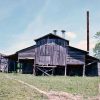 Goodlett Gin
Goodlett Gin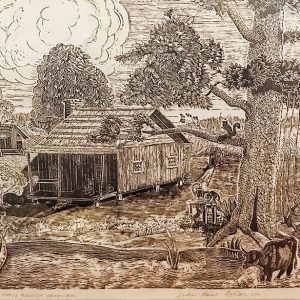 Bayou Homestead
Bayou Homestead 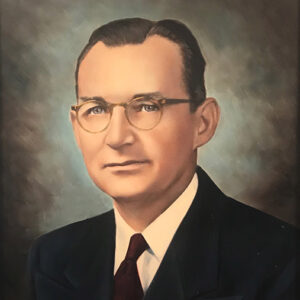 John Caldwell
John Caldwell 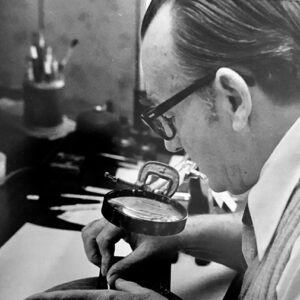 John Caldwell Working on a Woodcut
John Caldwell Working on a Woodcut 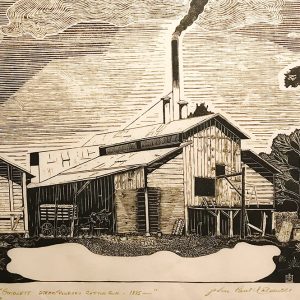 Goodlett Steam-Powered Cotton Gin
Goodlett Steam-Powered Cotton Gin 




Comments
No comments on this entry yet.